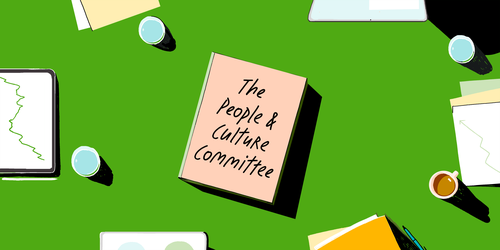A note from the series editor Didier Elzinga, Founder & CEO, Culture Amp.
Our first article in the Culture Shift series is an essay by an author and workplace cultural ambassador who we greatly admire at Culture Amp, Minda Harts.
Minda reflects on what it really means to build trust with your workforce, and the power of this story for me lies in this statement: “part of a CEO's job is to make every employee feel safe”. I think this advice applies equally to leaders at all levels and Minda has laid out practical steps leaders can take to achieve this whilst at the same time recognizing that all employees have a role to play in building a culture of trust.
As a new intern at an education start-up, my supervisor, a seasoned manager, once told me, "If the people you work with don't trust you, you better be ready to see a constant revolving door." As a 20-year-old still in college, that statement didn't mean much to me then. But I would soon learn in my workplace journey that trust should be the backbone of everything we do at work. You have nothing if you don't trust your leaders and colleagues (or they don't trust you).
As I navigated the complex terrains of various professional environments, his words kept returning to me. The rapidly changing world of work post-2020 is an area where trust has become even more paramount. I am sure you have seen that in your work too.
Being a leader in the 21st century has been a challenging feat. While we grapple with finalizing our new normal post-Covid, the quiet part we must admit is that our workplace today is different from before Spring 2020. The key to navigating these pristine waters? Trust.
“The key to navigating these pristine waters? Trust.”
The Merriam-Webster dictionary defines trust as the "ability, strength, or truth of someone or something." The past decade, filled with global technological upheavals, new work models, and evolving generational aspirations, underscored trust as a bedrock in this landscape.
I realize you understand the importance of trust as a core value, but did you know that creating, building, or restoring trust must be mandatory in the future of work, not optional? Studies have shown that employees are more likely to trust a stranger on the street than fully believe what their leadership does. This is because leaders’ actions don't always match their words. So, let's dig into how we can look at trust in the modern workplace through a new and fresh lens.
The trust crisis
Recent research around trust indicates a startling truth: only a third of employees trust their management. In an era where flexibility, remote work, and autonomy are gaining traction, a lack of trust in the workplace can seriously hamper engagement and productivity, especially for virtual teams.
The role of leaders in building and inspiring trust at work
From my journey in leadership roles, I've seen trust ebb and flow. We can all work at the same company or organization, but experience that workplace differently.
I spent 15 years in corporate and non-profit roles. In those roles, I was often the only person of color in the boardroom. When I was experiencing inequities at work, it was hard to know who to trust and confide in because I often felt there was no psychological safety or trust present. As a result, I didn't feel comfortable speaking up about it. Yet those in the dominant majority often felt comfortable addressing their concerns because their concerns weren't predicated on race and gender.
With that said, it’s not enough that some or even most employees feel safe – remember that part of a CEO's job is to make every employee feel safe, and; that feeling of safety should be part of an employee's bill of rights.
Factors undermining trust in modern workplaces
Just like any relationship, trust has to be earned; we can't just assume that trust is present because we are "the boss." Trust between employees and management isn't automatic! Trust doesn't happen automatically because of one's title. Many leaders often overlook the importance of trust. It's vital to remember that trust should be mutual.
We know that various factors are contributing to the erosion of trust in the workplace, so let's start by discussing three critical ones:
-
Lack of transparency: Rapidly made decisions need to be clearly communicated, or else employees will feel sidelined.
-
Generational differences: The desires of Millennials and Gen Z for transparency and purpose-driven work require leaders to take a new approach to work and the workplace.
-
Inconsistent policies: Without a long-term vision, quick policy decisions can create perceptions of injustice – something we saw play out during the COVID-19 pandemic.
With all three factors, it's important to note what we can do as leaders to help humanize our approaches to bridge the trust gap. Now, let's dive into strategies for rebuilding and fostering trust in the workplace.
How to rebuild and foster trust in the workplace
Here are a few tips to keep in mind as you go about making trust the main character at work:
-
Create a culture of purpose and growth. Empower your employees to transition from passive consumers of culture to active culture creators. By allowing employees to have a strong voice in shaping company culture, CEOs can ensure that confidence remains embedded in the fabric of the organization.
-
Prioritize open communication. Create channels where strategies are transparently shared.
-
Understand and respond to differences in generational expectations. Offer tailored training sessions for managers on understanding and integrating the values and preferences of different generations.
-
Ensure consistent and fair policies: Implement cross-functional policy review committees to evaluate the effectiveness and fairness of current policies. Regularly update policies to maintain fairness. For example, policies like remote work, performance bonus structure, and parental leave.
-
Invest in leadership training: Equip leaders with tools to understand and guide diverse teams.
-
Encourage feedback: Cultivate a space where feedback isn't just welcomed but acted upon. Having a feedback loop in place is foundational to building a trusting and more inclusive environment.
The responsibility of individuals in building trust
While organizations must create the right environment for trust, trust is a two-way street. Individuals must remove barriers for their colleagues and refrain from acting in ways that perpetuate distrust. Individuals can do this by:
- Being transparent about their needs
- Openly communicating their challenges
- Showing up consistently
By proactively following these guidelines, we can contribute to a culture of trust in our organizations, because all our actions, big or small, shape our collective workspace.
Trust is the bedrock
Trust isn't a luxury for thriving in today's workplace; it's an imperative. As we continue to rethink and reshape organizational culture, leaders and employees have a shared responsibility to build and foster trust at all levels of the organization. It's through this collaborative effort that companies can navigate the future with resilience and agility.
Keeping trust as the main character will require each of us at work to do our part because success is not a solo sport. If we want a workplace where everyone can show up and do their best work, it will require you, as the leader, to demonstrate why trust is more important than ever before.
As I end this message, I want to challenge you to start by asking a straightforward question to your team, "Do you trust me?" As you ask probing questions to understand why or why not, remember that being an active listener is key to creating trust.
![]()
![Why leaders should be paying serious attention to #worktok]()
![]()
![]()







